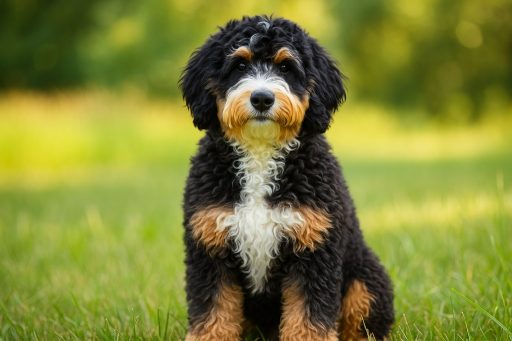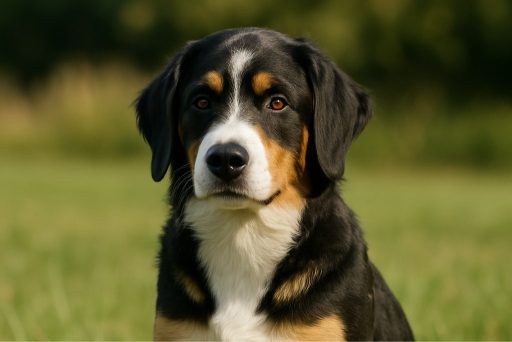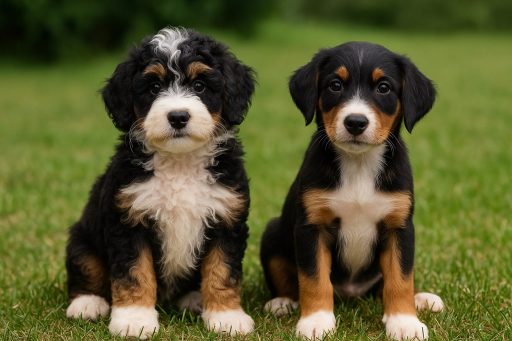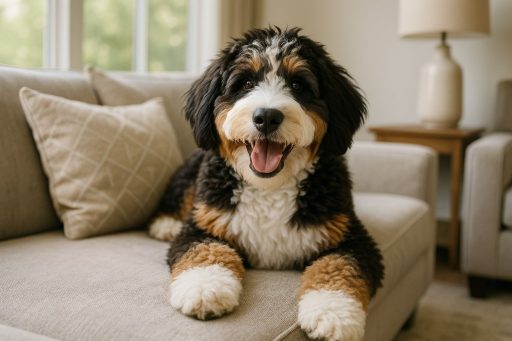As you research Bernedoodles, you’ve probably come across the terms furnished and unfurnished Bernedoodles.
In short, a furnished Bernedoodle has longer hair on the face, including the eyebrows, muzzle, and beard, giving that classic teddy-bear look. An unfurnished Bernedoodle, on the other hand, has a smoother face with short muzzle hair, more like a Bernese Mountain Dog.
There’s a bit more to that, though.
In this guide, we’ll walk you through everything you need to know about the furnished vs. unfurnished Bernedoodle, including what it means genetically and what to expect from each type.
🐶 Key Takeaways
- Furnished Bernedoodles have longer facial hair and curlier coats that resemble Poodles
- Unfurnished Bernedoodles have smoother faces and straighter hair like a Bernese Mountain Dog.
- The furnishing trait is linked to a single gene (RSPO2) with a dominant inheritance pattern.
- Puppies with at least one furnishing gene (F) will be furnished. Those with none (IC/IC) will be unfurnished.
- Grooming needs and allergy sensitivity vary depending on coat type.
- Coat type does not affect personality; both furnished and unfurnished Bernedoodles are affectionate, friendly, and playful.
What Is a Furnished Bernedoodle?

Furnished Bernedoodles are what many people picture when they think of this breed. They have a longer, thicker coat with a soft, wavy, or curly texture, often resembling a teddy bear.
This coat type is closer to the Poodle’s coat and is generally more hypoallergenic — it produces fewer allergens that trigger reactions in people with allergies.
👉 Key characteristics of a furnished coat
- Longer hair: The hair is noticeably longer, especially around the face, legs, and tail, giving them that classic “doodle” look.
- Wavy or curly texture: The coat has a distinct wave or curl, which can vary from loose waves to tight curls.
- Low-shedding: Furnished coats shed minimally, making them a good choice for people with allergies.
- Requires regular grooming: This coat type requires more frequent brushing and grooming to prevent matting and tangles.
What Is an Unfurnished Bernedoodle?

Unfurnished Bernedoodles have a shorter, straighter coat that more closely resembles the Bernese Mountain Dog’s coat.
While they are still considered low-shedding compared to many other breeds, unfurnished coats will shed more than furnished coats.
👉 Key characteristics of an unfurnished coat:
- Shorter hair: The hair is shorter overall, giving them a less fluffy appearance.
- Straight or slightly wavy texture: The coat is primarily straight or has a slight wave, lacking the distinct curls of a furnished coat.
- Will shed more: While still lower-shedding, unfurnished coats tend to shed more than furnished coats.
- Easier to groom: This coat type requires less intensive grooming compared to furnished coats.
What Determines Whether a Bernedoodle Is Furnished or Unfurnished?
The difference between a furnished and unfurnished Bernedoodle comes down to a single gene called RSPO2, often referred to as the furnishing gene. This gene determines if a dog develops longer hair around the muzzle and eyebrows — features that give Bernedoodles their classic shaggy, doodle-like look.
Dogs that inherit the furnishing gene grow a mustache, beard, and eyebrows. Those that don’t have a smooth face with short muzzle hair, similar to a Bernese Mountain Dog.
RSPO2 follows autosomal dominant inheritance, meaning a dog only needs one copy of the gene to show furnishings. It’s not a multi-gene trait; it works like an on/off switch controlled by this single gene.
Now, breeders often refer to furnishing genetics using coat alleles. These alleles affect both facial features and overall coat texture, including how fluffy or curly the dog looks.
Furnished Bernedoodles tend to have fuller, curlier coats, while unfurnished ones often have straighter or smoother fur, especially around the face and chest.
Breeders label the coat alleles as follows:
- F – Furnished (dominant variant of RSPO2)
- IC – Improper Coat (no furnishings, recessive)
A dog can inherit one of three possible combinations:
Now let’s apply this to Bernedoodle breeding:
🐶 Poodles usually carry F/F, which means they have two copies of the furnishing gene. When bred, they always pass on one F gene, so every puppy gets at least one furnishing allele, guaranteeing a furnished coat.
🐶 Bernese Mountain Dogs typically carry IC/IC, which means they don’t have any furnishing alleles. So when bred, they always pass on the IC gene, leading to unfurnished coats in their purebred lines.
🐶 In an F1 litter (Poodle × Bernese), each pup gets one F from the Poodle and one IC from the Bernese. That gives every puppy the F/IC genotype. Since one F is enough, all F1 pups are furnished, often with moderate to strong doodle traits.
🐶 In an F1B litter (F/IC × Poodle), the Poodle parent gives an F gene, and the F1 parent could give either F or IC. The result is a mix of F/F or F/IC, but all pups are furnished, and many have curlier, more Poodle-like coats due to the extra F gene influence.
🐶 In an F1B litter (F/IC × Bernese), the Bernese only contributes IC, and the F1 parent might pass on F or IC. So, pups will either be F/IC (furnished) or IC/IC (unfurnished). This pairing has a 50/50 chance of producing unfurnished pups.
🐶 In an F2 litter (F/IC × F/IC), both parents are carriers of the IC gene. That means their pups could get any combo: F/F, F/IC, or IC/IC. The expected distribution is:
- 25% unfurnished (IC/IC)
- 50% furnished carriers (F/IC)
- 25% fully furnished (F/F)
Because of this, breeders often use DNA testing to know exactly what coat genetics their dogs carry. But even without testing, one visual clue helps: By 6 to 8 weeks of age, pups with short, sleek muzzle hair are likely unfurnished or weakly furnished.
In short, a Bernedoodle needs at least one copy of the furnishing allele (F) to grow the classic doodle face. Only when a pup inherits no copies (IC/IC) will it have a smooth, unfurnished coat.
💡Important Note: Predicting a Bernedoodle puppy’s coat type with 100% certainty can be challenging, even for experienced breeders. While genetic testing can help determine the presence of the furnishing gene, the exact expression of the coat (how curly or wavy it will be) can vary.
Furnished vs. Unfurnished Doodle: Which One Suits You Better
Both furnished and unfurnished Bernedoodles have their own unique appeal, and the best choice depends on your lifestyle and preferences.
To make the right choice, think about your priorities related to allergies, grooming, and aesthetics.

🐶 Choose a furnished Bernedoodle if:
- You prefer the classic “teddy bear” doodle look.
- You have allergies and need a dog with minimal shedding.
- You’re prepared to commit to regular grooming to prevent matting.
🐶 Choose an unfurnished Bernedoodle if:
- You prefer a less fluffy, more “flat coat” look.
- You’re looking for a dog with a slightly easier grooming routine.
- You’re not concerned about shedding.
Find Your Perfect Bernedoodle at Central Illinois Bernedoodles

You might love the fluffy, teddy bear look of a furnished Bernedoodle. Or maybe you prefer the smooth face of an unfurnished one. Either way, the goal is to find a dog that fits your lifestyle and what you’re looking for in a companion.
If you have allergies, a furnished Bernedoodle can be a better fit. However, if allergies are not a concern and you prefer minimal brushing, opt for an unfurnished Bernedoodle.
If you’re ready to welcome a Bernedoodle into your home, you can count on Central Illinois Bernedoodles.
We’re a trusted Bernedoodle breeder in Illinois, and we’ll help you find your puppy match. Explore our available puppies today and find the newest addition to your family!
FAQs
Do furnished Bernedoodles require more grooming than unfurnished Bernedoodles?
Yes, furnished coats tend to mat and tangle more easily, so they need more frequent brushing and professional grooming.
Are unfurnished Bernedoodles still hypoallergenic?
While unfurnished Bernedoodles will shed more than furnished ones, they are still considered low-shedding. However, if you have allergies, we highly recommend a furnished Bernedoodle.
Do furnished and unfurnished Bernedoodles have different temperaments?
No, coat type doesn’t affect temperament. Both furnished and unfurnished Bernedoodles are known for their friendly, affectionate, and playful personalities.

